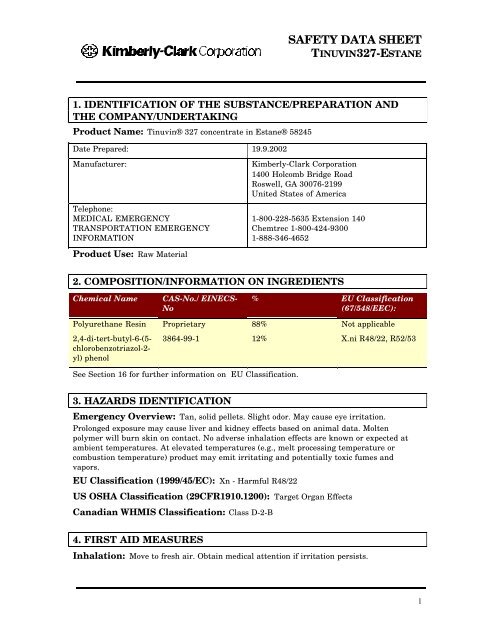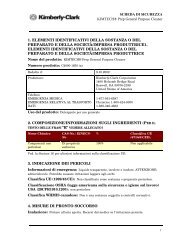SAFETY DATA SHEET - Industrial Health and Safety Consultants, Inc.
SAFETY DATA SHEET - Industrial Health and Safety Consultants, Inc.
SAFETY DATA SHEET - Industrial Health and Safety Consultants, Inc.
You also want an ePaper? Increase the reach of your titles
YUMPU automatically turns print PDFs into web optimized ePapers that Google loves.
<strong>SAFETY</strong> <strong>DATA</strong> <strong>SHEET</strong><br />
TINUVIN327-ESTANE<br />
1. IDENTIFICATION OF THE SUBSTANCE/PREPARATION AND<br />
THE COMPANY/UNDERTAKING<br />
Product Name: Tinuvin® 327 concentrate in Estane® 58245<br />
Date Prepared: 19.9.2002<br />
Manufacturer:<br />
Telephone:<br />
MEDICAL EMERGENCY<br />
TRANSPORTATION EMERGENCY<br />
INFORMATION<br />
Kimberly-Clark Corporation<br />
1400 Holcomb Bridge Road<br />
Roswell, GA 30076-2199<br />
United States of America<br />
1-800-228-5635 Extension 140<br />
Chemtrec 1-800-424-9300<br />
1-888-346-4652<br />
Product Use: Raw Material<br />
2. COMPOSITION/INFORMATION ON INGREDIENTS<br />
Chemical Name<br />
CAS-No./ EINECS-<br />
No<br />
% EU Classification<br />
(67/548/EEC):<br />
Polyurethane Resin Proprietary 88% Not applicable<br />
2,4-di-tert-butyl-6-(5-<br />
chlorobenzotriazol-2-<br />
yl) phenol<br />
3864-99-1 12% X.ni R48/22, R52/53<br />
See Section 16 for further information on EU Classification.<br />
3. HAZARDS IDENTIFICATION<br />
Emergency Overview: Tan, solid pellets. Slight odor. May cause eye irritation.<br />
Prolonged exposure may cause liver <strong>and</strong> kidney effects based on animal data. Molten<br />
polymer will burn skin on contact. No adverse inhalation effects are known or expected at<br />
ambient temperatures. At elevated temperatures (e.g., melt processing temperature or<br />
combustion temperature) product may emit irritating <strong>and</strong> potentially toxic fumes <strong>and</strong><br />
vapors.<br />
EU Classification (1999/45/EC): Xn - Harmful R48/22<br />
US OSHA Classification (29CFR1910.1200): Target Organ Effects<br />
Canadian WHMIS Classification: Class D-2-B<br />
4. FIRST AID MEASURES<br />
Inhalation: Move to fresh air. Obtain medical attention if irritation persists.<br />
1
<strong>SAFETY</strong> <strong>DATA</strong> <strong>SHEET</strong><br />
TINUVIN327-ESTANE<br />
Skin contact: Wash off with soap <strong>and</strong> water. Obtain medical attention if irritation<br />
persists. If contact with molten polymer occurs, cool rapidly under running water. Do not<br />
attempt to remove material adhering to the skin. Obtain immediate medical attention.<br />
Eye contact: Rinse with plenty of water. Obtain medical attention.<br />
Ingestion: Obtain medical attention.<br />
5. FIRE-FIGHTING MEASURES<br />
Flashpoint: 752ºF (400ºC)<br />
Autoignition temperature: >765ºF (407ºC)<br />
Flammable Limits in Air % by Volume:<br />
LEL (Lower): Not applicable<br />
UEL (Upper): Not applicable<br />
Suitable Extinguishing Media: Water, water fog, foam, carbon dioxide, dry chemical.<br />
Special Fire Fighting Procedures: Wear self-contained breathing apparatus <strong>and</strong><br />
protective suit. Water may be used to keep exposed containers cool.<br />
Unusual Fire <strong>and</strong> Explosion Hazards: Product will burn under fire conditions. Large<br />
masses of product held at elevated temperatures for prolonged periods may autoignite.<br />
This product may build up electrostatic charge on pouring or transferring. The spark<br />
produced may ignite flammable gases or vapors. Avoid pouring into combustible or<br />
flammable solvents.<br />
Hazardous Combustion Products: Combustion may produce oxides of carbon,<br />
nitrogen oxides, hydrocarbons, isocyanates, <strong>and</strong> small amounts of hydrogen cyanide.<br />
6. ACCIDENTAL RELEASE MEASURES<br />
Carefully sweep up <strong>and</strong> place in a container for reuse or disposal.<br />
7. HANDLING AND STORAGE<br />
Avoid contact with skin <strong>and</strong> eyes. Wash thoroughly with soap <strong>and</strong> water after h<strong>and</strong>ling.<br />
Avoid sparks, flame <strong>and</strong> excessive heat. Minimize the generation <strong>and</strong> accumulation of dust.<br />
8. EXPOSURE CONTROLS / PERSONAL PROTECTION<br />
Chemical Name<br />
Polyurethane Resin<br />
2,4-di-tert-butyl-6-(5-chlorobenzotriazol-2-yl)<br />
phenol<br />
Exposure limit(s)<br />
None established<br />
2.5 mg/m3(manufacturer recommended)<br />
2
<strong>SAFETY</strong> <strong>DATA</strong> <strong>SHEET</strong><br />
TINUVIN327-ESTANE<br />
Ventilation: Local exhaust ventilation recommended at points of emission to reduce<br />
exposure to fumes <strong>and</strong> vapors during processing.<br />
Respiratory Protection: If the exposure limit is exceeded or for symptoms of<br />
overexposure, wear an appropriate NIOSH (or local authority) approved respirator.<br />
Protective Gloves: Impervious gloves recommended as good industrial hygiene practice.<br />
Eye Protection: <strong>Safety</strong> glasses or goggles recommended.<br />
9. PHYSICAL AND CHEMICAL PROPERTIES<br />
Appearance <strong>and</strong> Odor<br />
Boiling point/range<br />
Melting point/range<br />
Tan, solid pellets.Slight odor.<br />
Not applicable<br />
Not available<br />
Specific Gravity (water=1) 1.2-1.3<br />
Vapor pressure<br />
Vapor density (air=1)<br />
Solubility<br />
pH<br />
Partition coefficient (n-octanol/water):<br />
Evaporation Rate (Butyl acetate=1)<br />
Volatile Organic Carbon Compounds (VOC)<br />
(g/L)<br />
Percent Volatile by Volume (%) 0<br />
negligible<br />
Not applicable<br />
Insoluble<br />
Not applicable<br />
Not available<br />
Not applicable<br />
None.<br />
10. STABILITY AND REACTIVITY<br />
Stability: Stable<br />
Conditions to Avoid: Keep away from heat <strong>and</strong> sources of ignition.<br />
Materials to avoid: <strong>Inc</strong>ompatible with acids <strong>and</strong> bases. <strong>Inc</strong>ompatible with oxidizing<br />
agents.<br />
Hazardous Decomposition Products: Combustion may produce oxides of carbon,<br />
nitrogen oxides, hydrocarbons, isocyanates, <strong>and</strong> small amounts of hydrogen cyanide. At<br />
elevated temperatures (e.g., melt processing temperature or combustion temperature)<br />
product may emit irritating <strong>and</strong> potentially toxic fumes <strong>and</strong> vapors.<br />
Hazardous Polymerization: Does not occur.<br />
11. TOXICOLOGICAL INFORMATION<br />
Symptoms/Effects of Overexposure:<br />
3
<strong>SAFETY</strong> <strong>DATA</strong> <strong>SHEET</strong><br />
TINUVIN327-ESTANE<br />
Inhalation: No adverse inhalation effects are known or expected at ambient temperatures.<br />
Inhalation of processing vapors <strong>and</strong> fumes may cause moderate to severe respiratory<br />
irritation.<br />
Skin contact: Prolonged contact may cause mild irritation in sensitive individuals.<br />
Molten polymer will burn skin on contact.<br />
Eye contact: May cause eye irritation.<br />
Ingestion: Prolonged exposure may cause liver <strong>and</strong> kidney effects based on animal data.<br />
Chronic toxicity: Prolonged exposure may cause liver <strong>and</strong> kidney effects based on<br />
animal data.<br />
Medical Conditions Aggravated by Exposure: None currently known.<br />
Carcinogenicity Data: None of the components of this product is listed as a carcinogen<br />
by IARC, NTP or OSHA.<br />
Reproductive Toxicity: No adverse effects on reproduction are known.<br />
Acute Toxicity Values: No data available<br />
12. ECOLOGICAL INFORMATION<br />
2,4-di-tert-butyl-6-(5-chlorobenzotriazol-2-yl)<br />
phenol<br />
LC50 Fish >100 mg/L.EC50 Daphnia 16<br />
mg/L.Not Biodegradable.<br />
13. DISPOSAL CONSIDERATIONS<br />
Dispose in accordance with all state, local <strong>and</strong> federal regulations.<br />
14. TRANSPORT INFORMATION<br />
US DOT Shipping Description: Not regulated<br />
IATA Shipping Description (Air): Not regulated<br />
IMDG Shipping Description (Vessel): Not regulated<br />
15. REGULATORY INFORMATION<br />
US Regulations<br />
EPA Toxic Substances Control Act (TSCA): All of the components of this product<br />
are listed on the TSCA Inventory or exempted from TSCA.<br />
SARA 302 Listed Chemicals: None.<br />
SARA 311/312 Hazard Categories: Chronic <strong>Health</strong><br />
SARA 313 This Product Contains the Following Chemicals Subject to<br />
Annual Release Reporting Requirements Under the SARA Section 313 (40<br />
CFR 372): None.<br />
4
<strong>SAFETY</strong> <strong>DATA</strong> <strong>SHEET</strong><br />
TINUVIN327-ESTANE<br />
California Proposition 65: This product does not contain chemicals listed per the Safe<br />
Drinking Water <strong>and</strong> Toxic Enforcement Act of 1986.<br />
International Regulations<br />
Canadian WHMIS Classification:<br />
Chronic Effects<br />
This product has been classified in accordance with the hazard criteria of the CPR <strong>and</strong> the<br />
MSDS contains all the information required by the CPR.<br />
EU EINECS Status: All of the components of this product are listed on the EINECS<br />
Inventory or exempted from notification.<br />
EU Labeling:<br />
R48/22 - Harmful: danger of serious damage to health by prolonged exposure if swallowed.<br />
S36 - Wear suitable protective clothing.<br />
16. OTHER INFORMATION<br />
HMIS Rating: <strong>Health</strong> 2 Fire 1 Reactivity 0<br />
The information is true <strong>and</strong> correct to the best of our knowledge; however, no warranty,<br />
expressed or implied, is made. Nothing should be interpreted as a recommendation to<br />
infringe on existing patents or violate any regulations. Final determination of the suitability<br />
of the material is the sole responsibility of the user.<br />
5














